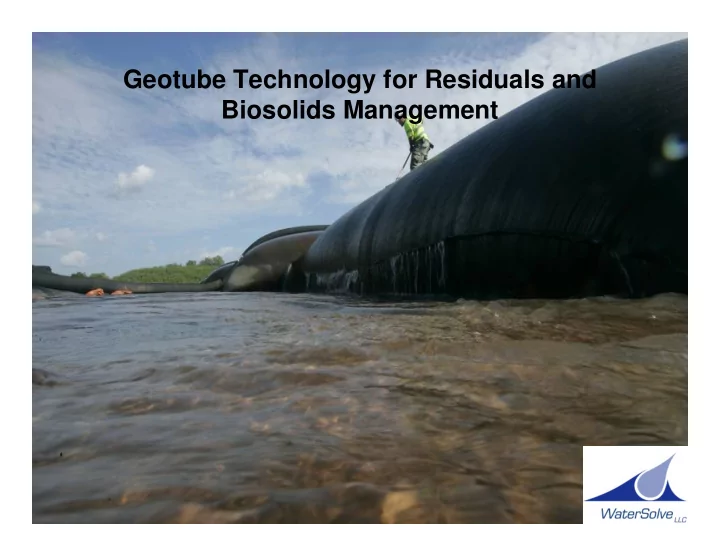

Geotube Technology for Residuals and Biosolids Management
Introduction Outline – Geotextile Container Introduction – Chemical Conditioning Programs – Feasibility Evaluations – Online Optimization – Case Studies
What is a Geotextile Container? • Geotextile Containers offer a high volume, high flow containment option, for dewatering and consolidation of hydraulically dredged material.
Containment Dewatering Consolidation
Use of Geotextile Containers Geotextile Containers Can be used for – Coarse-grain sediments – Fine-grain sediments
Coarse - Grain Sediment • Geotextile Containers have been used to form berms, stabilize beaches, prevent erosion, form levees, peninsulas, groynes, and other manmade structures. • Offer shear strength for landfill cap-in-place projects.
Fine-Grained Sediments • Technological advances in the application of dewatering chemistry and Tube construction allows for containment of solids and contaminants, while providing a clean, safe effluent of water that can be returned to the receiving system. • Geotextile Containers can now be used to dewater and contain Metals, Dioxins, PCBs, PAHs, Pesticides, Clays, Silt, and other organic materials.
Chemical Conditioning Optimization What are my dewatering objectives? • Containment/Consolidation • Effluent Water Characteristics • Time to dryness Total Dryness • What are my chemical conditioning choices? • Organic Flocculents • Organic Coagulants • Inorganic Coagulants • Hybrid Chemistries
Common Thread Chemical Conditioning
Polymer Selection Coagulation or Charge Neutralization – “like getting magnets to come together” • Cationic • Anionic • Nonionic Flocculation – “to sweep the magnets together into a pile” • Molecular weight
Principles of flocculation + + + - - - + - + - + - - - - + - + - - + - - + - - + - - + - + - + + - + + - - + - + - + - - - + - - - + - - - + - + + + - - + + - + - + + - + - - + - + - + + - - + - - + - +
Flocculation Before Flocculant is added After Flocculant is added
“Traditional” Product Selection 100 90 90A-low 90B-medium 80 80B-medium Charge density 70 70A-low 70C-high 60 60A-low 60B-medium 100 50 50A-low 50C-high 90 90B-branched 40 40A-low 40B-medium 40C-high 80 80C-high 30 30C-high Charge Density 70 70A-slight 70B-branched 20 20A-low 20B-medium 60 60A-slight 60B-branched 10 10A-low 10C-high 50 50A-slight 0 40 40B-branched 40C-high Molecular weight 30 30A-slight 30C-high 20 20A-slight 20B-branched 10 10A-slight 0 Structure
“Traditional” Product Selection 70A-low 100 69A-low 90 90A-low 90B-medium 68A-low 67A-low 80 80B-medium Charge density 66A-low 70 70A-low 70C-high 65A-low 60 60A-low 60B-medium 64A-low 50 50A-low 50C-high 63A-low 40 40A-low 40B-medium 40C-high 62A-low 30 30C-high 61A-low 20 20A-low 20B-medium 60A-low 10 10A-low 10C-high 0 Molecular weight
Advancements in “Site-specific” Product Selection 70A-low 100 69A-low 90 90A-low 90B-medium 68A-low 67A-low 80 80B-medium Charge density 66A-low 70 70A-low 70C-high 65A-low 60 60A-low 60B-medium 64A-low 50 50A-low 50C-high 63A-low 40 40A-low 40B-medium 40C-high 62A-low 30 30C-high 61A-low 20 20A-low 20B-medium 60A-low 10 10A-low 10C-high 0 Molecular weight
Polymer Selection Polymer Forms • Dry • Emulsion • Solution
Chemical Optimization Factors Affecting Product Selection Make-down requirements Feed equipment requirements Handling Lead times/availability Shelf life Storage/Use Environment Aquatic Toxicity $/lb Once determined: Must evaluate those products on the bench and in small scale studies.
Jar Testing “what to look for” • Release of free water • Water clarity • Floc Appearance • Water release rate • Dose optimization • Filtered water targeted constituents removed
“Site-specific” chemical conditioning program • Identify charge density, molecular weight, and structure of optimal chemistry through bench testing • Manufacture the chemistry • Test chemistry in Performance Trials (Hanging Bag Test or GDT)!
“What to look for in our Performance Trials” • Timeline to target dryness • Filtrate quality • Volume released • Conditioning efficiency & effectiveness � Provides operational data � Time to dryness and final outcome predictions can be made
GDT Test Collect samples of the sludge material to be dewatered.
GDT Test Pour all of the collected sludge into a 50 gallon container.
GDT Test Mix polymer thoroughly with the collected sludge until a floc forms.
GDT Test Pour the sludge into the GDT bag.
GDT Test Lift the stand pipe slightly to facilitate initial flow into the bag. Continue adding sludge until it reaches the mark on the stand pipe indicating 1psi.
GDT Test Collect, measure, and analyze the effluent water draining from the test unit.
GDT Test After the test bag dewaters, a sample of sludge can be collected to determine moisture content and percent dewatered solids. This can help to predict results in a full scale project.
Online Optimization Considerations: •Mixing energy/Shear energy • Slurry flow rate • Water flow rate, water pressure • Make-down contact time •Density (watch out for sand) or Flow meter Control of Feed equipment • Pre or Post-dilution water in the slurry
Pilot Scale Test Smaller Geotextile Containers can simulate operational conditions when space, time, and/or budget considerations apply.
Pilot Scale Test Larger scale pilot tests can also be used (if space and budget allow) to provide very detailed information.
Pilot Scale Test – Deliverables • Filtrate quality Dewatering rate • • Consolidation • Dosing and dose control • Chemistry injection points • Dilutions of slurry Chemical use costs • • Time to dryness • Total dryness Other operational parameters to aid in full scale estimators •
Use Software for Predictability Use Software Programs to Predict Quantity of Geotextile Containers
Simulator Programs Use SIMULATOR Programs to offer � Dimensions � Volumes � Stresses.
WaterSolve, LLC 4964 Starr Street, SE Grand Rapids, MI 49546 (616) 575-8693 (616) 575-9031 (fax) www.gowatersolve.com www.geotube.com
Recommend
More recommend